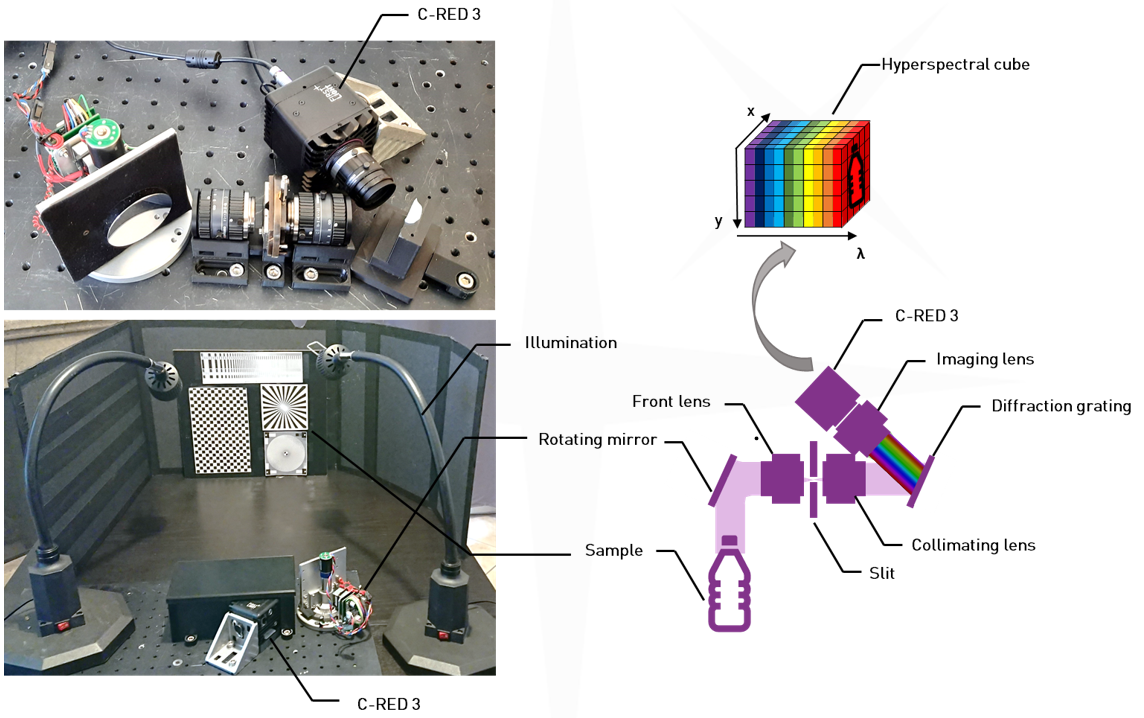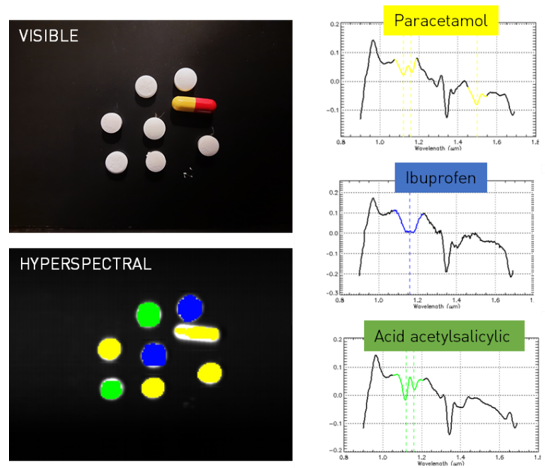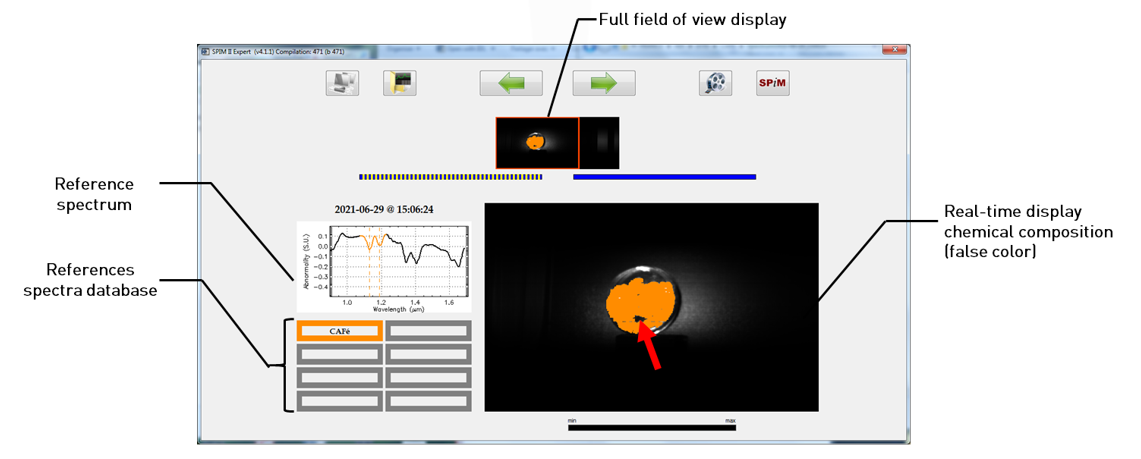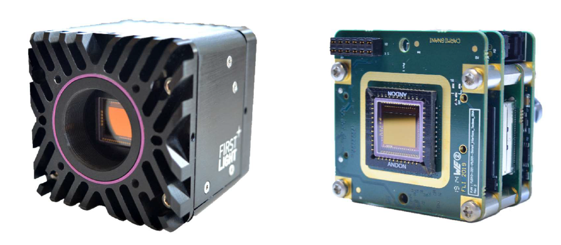Resources
 Part of the Oxford Instruments Group
Part of the Oxford Instruments Group
Expand
Collapse
 Part of the Oxford Instruments Group
Part of the Oxford Instruments Group
Hyperspectral imaging combines conventional spectroscopy and imaging to simultaneously gather spectral and spatial information. The sensitivity and speed of the C-RED 3 camera are key assets to optimize the throughput of such systems. A system running at 1200 Hz is designed and tested on standard use cases to demonstrate the feasibility of high-speed hyperspectral imaging.
HyperSpectral Imaging (HSI) combines digital imaging to spectroscopy. In other words, HSI adds a spectral dimension to conventional imaging. Originally developed for remote sensing of earth from aircrafts or satellite, it is a mature technique for the analysis of agricultural fields, forest, or mines. In the past few years, it has emerged as an important tool for the industrial analyses of products (drugs, plastics, food, etc.). In the SWIR band (900-1700 nm) HSI is an emerging technology for production control. The advantages of simultaneous access to spatial and spectral characteristics of an object provide valuable information on the chemical composition of its surface.
HSI consists in acquiring a data cube of two spatial dimensions (x,y) and one spectral dimension (λ). The most common configuration is the “push-broom” technique: a spatial line (y) and the whole spectral range are acquired simultaneously by a camera. The second spatial dimension (x) is scanned over time. The scanning principle ensures that the spatial and spectral resolution are independent from one another, resulting in optimized performances for both. The spectral signature at each spatial coordinate provides information on the chemical composition of the object at that location.

Hyperspectral imaging basic principle. A series of (y, λ) frames are acquired in time to generate a (x, y, λ) hyperspectral data cube. The spectral signature of the object at each position (x, y) is contained in the cube.
Due to the distance between the camera and the scene to be analyzed, speed acquisition was not a limiting parameter for airborne HSI applications. With new markets come new challenges. Most HSI systems lack the speed to comply to the conveyors used in industrial production lines. It is becoming crucial to increase the acquisition speed of hyperspectral imagers to meet productivity requirements.
In push-broom configuration, for a given spectral and spatial resolution, the speed at which the system can analyze a product is directly correlated to the maximum framerate of the camera. At high framerates, the integration times are necessarily low and a sensitive camera, with low readout noise, is required.
Take-home message
Hyperspectral imaging combines spatial resolution to spectral information. New industrial applications bring the need for high throughput systems, based on high framerate and high sensitivity cameras.
To demonstrate the feasibility of very high-speed SWIR hyperspectral imaging, First Light Imaging and ATIS 2.0 have developed a Proof-of-Concept standalone system in push-broom configuration. The device achieves a framerate of 1200Hz with 640 spatial pixels and a 3.4 nm spectral resolution.
Light reflected by the object is captured by a front lens. A single spatial dimension (y) is filtered by a slit, i.e., two razor blades. The distance between them can be manually tuned to optimize the spectral resolution. Then, the collimating lens reimages the slit on infinity. The spectrum is split by the reflection grating and imaged with the imaging lens. The camera captures a frame with (y, λ) information. The second spatial dimension is gathered by scanning the scene with a motorized mirror. A common alternative to this solution is to have the object moving linearly (ex: a conveyor).

Pictures of the hyperspectral imager and complete experimental set up & Schematic representation
The efficiency of the grating depends on the blaze angle (i.e., wavelength of maximum efficiency) and the incidence angle. The combination of the grating with the imaging objective determines the number of spectral bands and the vertical field of view. A grating with 150 grooves/mm and a 5.4° nominal blaze angle (i.e., central wavelength 1250 nm) combined to a 25 mm focal length objective lens ensures a spectral sampling of 3.4 nm to our system. The two other objective lenses impact the spectral resolution and the vertical field of view. For the sake of simplicity and to minimize bulkiness their focal length is also 25 mm.
The C-RED 3 Software Development Kit (SDK) was used to integrate the camera in the HSI software developed by ATIS 2.0. The software provides real-time identification of chemicals and complete control of the system and data acquisition. The chemical imaging of multiple material simultaneously on the interface is possible. Hyperspectral data may also be exported towards MatLab or ENVI.
Hyperspectral data cubes require processing operations to provide the chemical information, this is achieved on-the-fly by the software. The spectral signature of the object at each (x,y) position is compared, using convolution operations, to a database of pre-saved reference spectra. If the confidence index of the correlation is sufficiently high, then the chemical composition of the studied object can be inferred. The workflow is illustrated below, with the example of a plastic bottle made up of different materials for the cap and the body.

Schematic representation of the processing workflow
A preliminary calibration phase is necessary to create the reference spectra data base. Spatially homogeneous samples of known composition are imaged using the system and the averaged spectrum is saved in the data base.
The following table sums up the performances of the Proof-of-Concept system.
| Camera | Model | C-RED 3 |
| Detector | InGaAs | |
| Resolution | 640 X 512 pixels | |
| Pixel pitch | 15 um | |
| Control interface | USB 3 | |
| Region Of Interest (ROI) | Yes | |
| ADC resolution | 14 bits | |
| System | Aperture | F/ 1.4 |
| Dimensions | 160 X 120 mm | |
| Speed (230 bands) | 1200 fps | |
| Speed (4 bands) | 24 000 fps | |
| Spectral performances | Spectral range | 900 - 1700 nm |
| Spectral bands | 230 | |
| Spectral sampling | 3.4 nm | |
| Spatial performances | Resolution | 640 pixels |
| Field of view (vertical) | 20° | |
| Field of view (horizontal) | Up to 35° |
The spectral resolution ensures a high discretization of the spectral signature which enables a precise characterization of the chemical composition. Spatial resolution ensures a high level of details and facilitates the detection of small objects.
Hyperspectral data cubes are acquired as a function of time. High temporal resolution enables the characterization of moving objects and time dependent events. With the system described, a hyperspectral data cube covering a spatial field of view of 35° by 20° with a spectral resolution of 3.4 nm over a spectral range of 900 – 1700 nm can be acquired every second!
Hyperspectral imaging offers a contact-less, non-destructive, and fast solution to analyze or sort objects. Hyperspectral imagers can be used in industrial vision. Production lines applications include quality control, detection of defects or foreign body, etc. Objects are often placed on conveyors which perform the spatial scanning and ensure the production rate. As a demonstration of high-speed hyperspectral imaging, the developed system is used in live conditions on a few typical use cases. The software provides a dynamical display of the spatially resolved image and a false color overlay of the qualitative composition analysis.

Mixed pills imaged with a visible camera and with the hyperspectral imaging system (false color display). The experimental spectra of the products are shown.
In the pharmaceutical industry, hyperspectral imagers can be used to address several challenges, one of them being product identification.
In the experiment, the naked eye cannot differentiate the three pharmaceutical products: paracetamol, ibuprofen and acid acetylsalicylic (aspirin) nor identify the product in the bi-color capsule.
The discriminative information contained in the spectra are highlighted in color and the main absorption peaks are indicated by a dashed line. Such results could be used for quality monitoring or sorting of the pills.
In the food industry, hyperspectral imagers are implemented for sorting and quality monitoring. In the later, the aim is to detect impurities (soil, stones, inclusions, etc.) or defects (bruises, etc.). Single point monitoring based on spectroscopy is widely used but spatial resolution ensures a higher coverage of the control and reduces the risk of food contamination.
The experiment aims to detect the presence of a contaminant in a container of coffee beans. The bean spectrum is part of the reference database. In the image below, the “good” objects (beans) are colored in orange. The red arrow points to a zone of low correlation between the sample and the reference coffee spectrum. The presence of a contaminant is thus suspected. Thanks to the real-time display, an immediate action can be taken to isolate the sample.

Screenshot of the hyperspectral imaging software used for the experiments.
Hyperspectral imaging systems allow precise sorting of recyclable materials, such as plastics. The need for an effective technique to detect, characterize and sort waste products is a major challenge in the waste industry. The amount of material that can be recycled directly depends on the capability of the sorting technology. Plastics are difficult to sort because although their chemical composition vary, their weight, color and density are similar.
To illustrate the application with a high-speed hyperspectral imager, a set of plastic objects is studied. The spectral signatures are retrieved from the hyperspectral data cubes. As shown below, the spectral data was specific to each material. Hence, the classification of plastics was possible using the hyperspectral imager. Similarly, different textiles (cotton, wool, linen, etc.) have specific spectral characteristics that can be used to classify fabrics.

Various plastic samples and their specific spectral signatures that enable differentiation.
To illustrate the high-speed performance of the system, a hyperspectral movie of our favorite Lego® figure driving a motorcycle across the experimental board was acquired.
The calibration is done on the Lego® figure itself. Four types of plastics (helmet, hand, motorcycle, and body) are pre-classified in the database.

The full spatial resolution (320 by 720 spatial pixels and 230 spectral bands) is acquired during movement. The result of the hyperspectral processing operation is displayed below. Thanks to the system snapshot capacity, the image is not blurred and the spatial composition of the Lego® can be precisely studied at each time point.

Consecutive hyperspectral images of Lego® figure Bob driving fast on his motorcycle. The processed images are displayed in real time in the SPiM software interface.
Take-home message
The sensitivity of C-RED 3 enables to acquire high signal to noise ratio data sets at small integration times. This enables to run the system at the full speed allowed by the camera: 1200 frames per second in a 320 y-pixels by 230 bands configuration.
Designed specifically to address the industry market and benefiting from the expertise gained on high end scientific cameras, First Light Imaging’s C-RED 3 offers numerous assets for hyperspectral imaging.

C-RED 3 camera, in housed (left) and OEM formats (right).
In the C-RED 3 camera, all the cooling system has been removed and the electronics squeezed to give a very compact high-speed SWIR camera. Below is an insight into its advantages.
C-RED 3 is a plug-and-play SWIR camera.
Our C-RED range of cameras offers hardware optimization to adjust to your specific use case.
Hyperspectral imaging (HSI) combines spatial resolution to a spectral dimension, offering a spatially resolved technique for the analysis of objects’ chemical composition. In short, HSI adds a spectral dimension to conventional imaging. The measurements are made from a remote distance (non-contact) without any invasiveness. The current challenge is to increase the speed of hyperspectral imaging to meet that of industrial conveyors, so that analysis is done on-the-fly. Optimizing productivity is a common challenge to all industries. Hyperspectral imaging has been demonstrated to be useful in the pharmaceutical industry, the food industry, the recycling industry, quality control, etc.
The full experiment with C-RED 3 described in this note illustrates the performances of a high-speed hyperspectral imaging system. Various objects were imaged to demonstrate the sensitivity of the camera and its ability to perform high speed imaging at short integration times. The workflow, from experimental image acquisition to data processing is described. Materials were accurately classified and chemical analysis maps could be displayed in real-time.
C-RED 3 is an industrial SWIR camera designed for industrial applications. It enables very high-speed high-quality imaging (up to 600 fps in full frame) and gives its best performances at short exposure times.
With C-RED 3, very high-speed hyperspectral imaging is within your reach!
And as we want our customers to always stay one step ahead in their own market, C-RED 3 is available in OEM version to speed up custom developments and mechanical integration.

The ATiS 2.0 team are specialists of hyperspectral imaging systems and image processing, especially in the infrared domain. First Light Imaging acknowledges the fruitful collaboration with ATiS 2.0 for the design and assembly of the hyperspectral imaging system, the customization of the HSI software, and the experimental campaign.
Date: September 2021
Author: Cecile Brun
Category: Application Note
